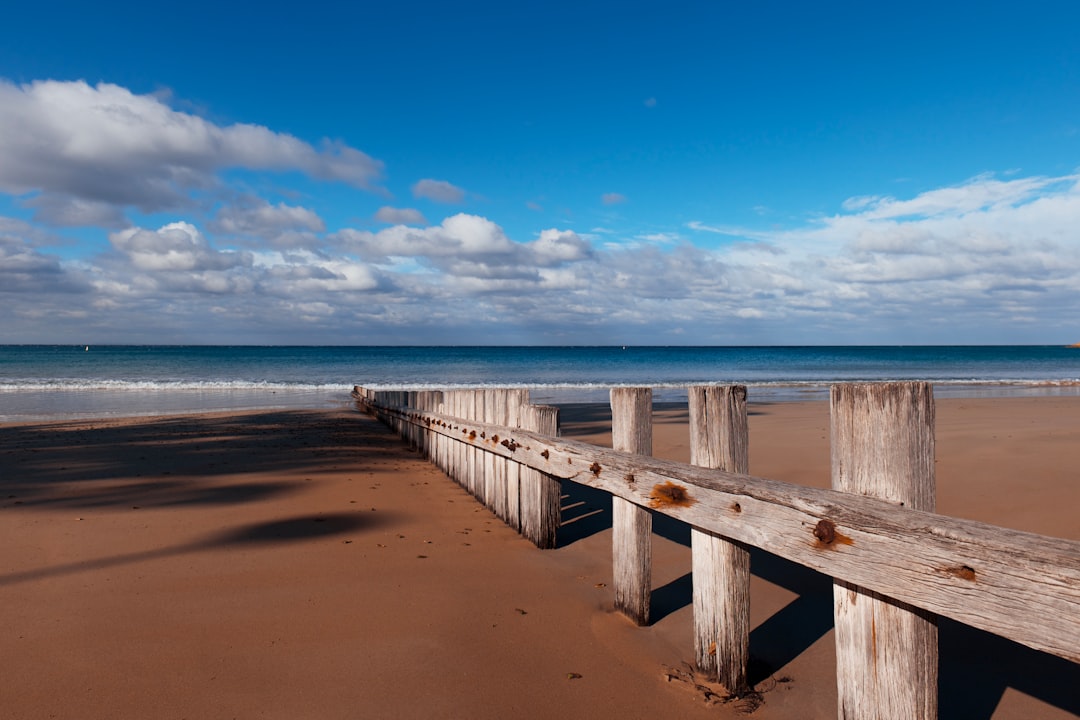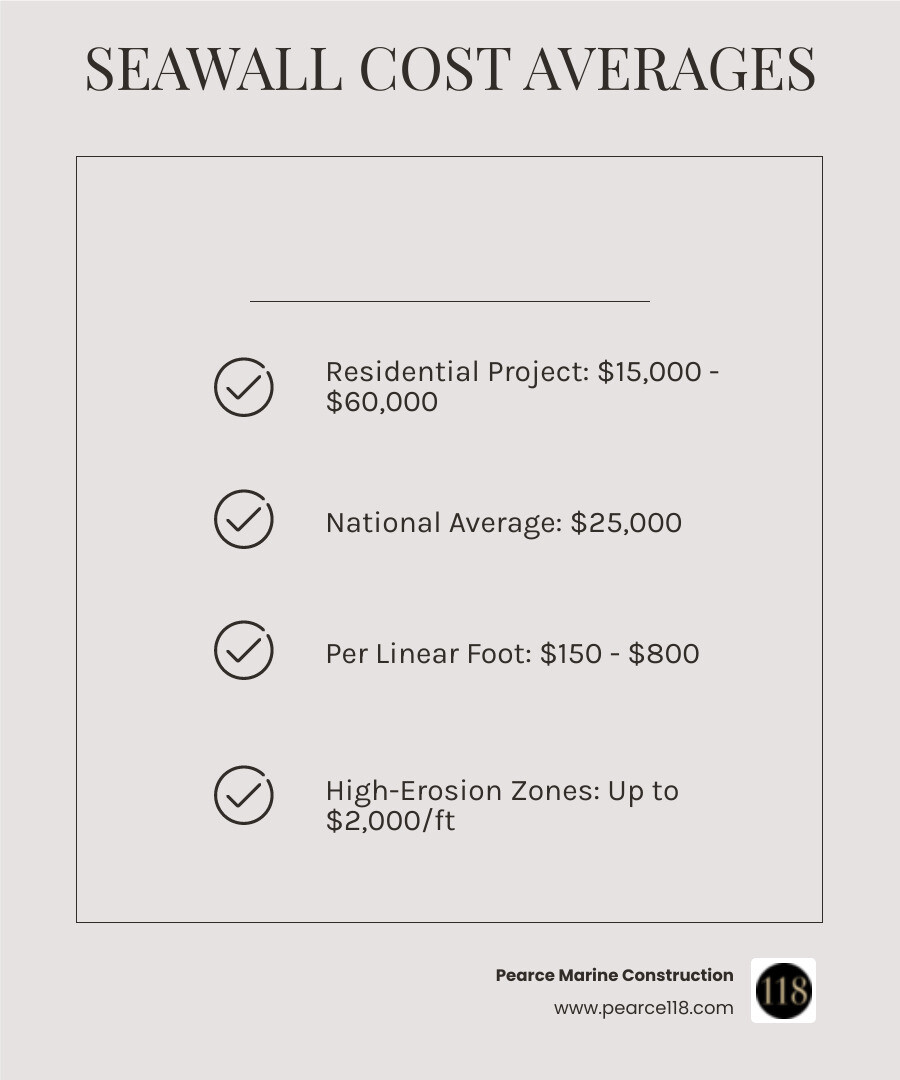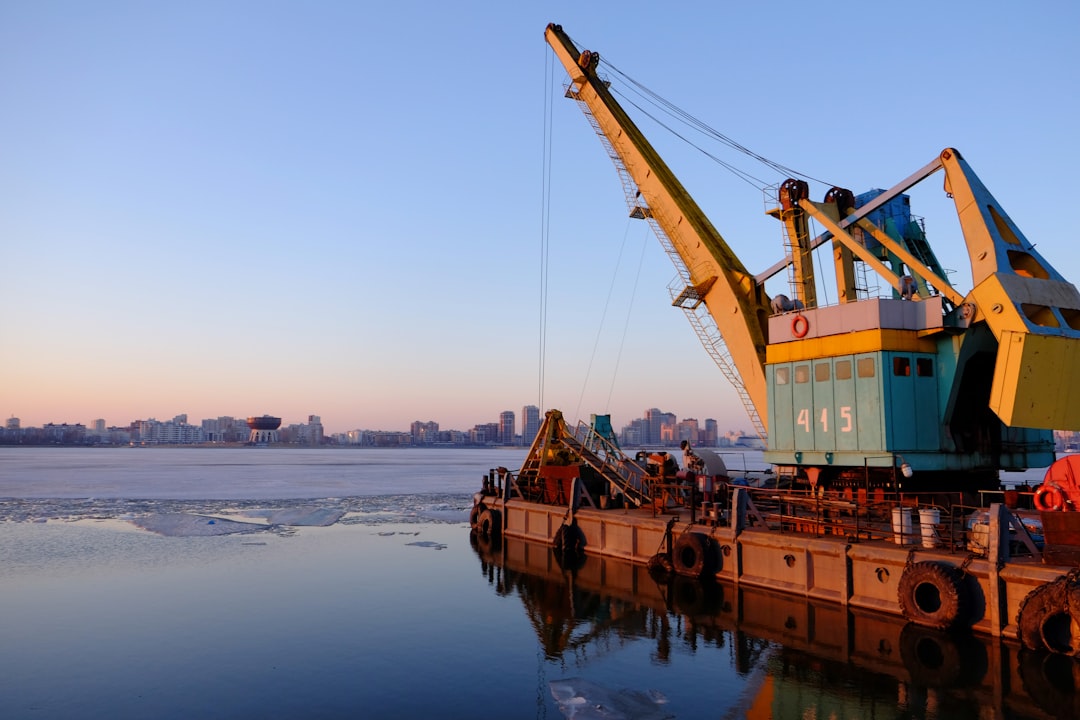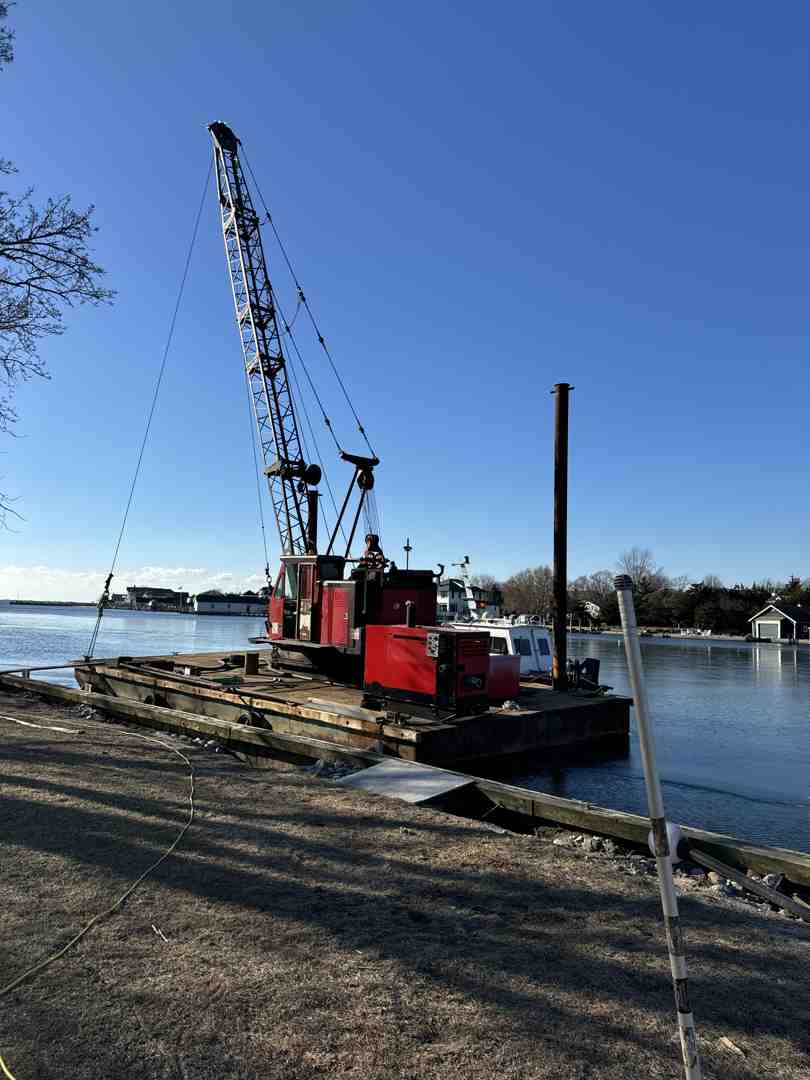Don't Get Washed Away: Your Guide to Seawall Pricing

Your Quick Guide to Seawall Costs
The Cost of a seawall can vary, but understanding the average figures is a crucial starting point for any Long Island property owner. A seawall is a vital investment to protect your waterfront property from erosion and storm damage. For a broader look at how these structures are used worldwide, see this helpful seawall reference.
Here are the typical cost ranges you might expect:
- Average Residential Project: $15,000 to $60,000
- National Average: Around $25,000
- Per Linear Foot: $150 to $800, depending on materials and complexity
- High-Erosion or Commercial Zones: Can reach $700 to $2,000 per linear foot.
The final price depends on many factors, from the materials you choose to the unique conditions of your waterfront property. At Pearce Marine Construction, we understand these complexities and are here to help you invest in durable, custom shoreline solutions for your Long Island property.

What is the Average Cost of a Seawall?
When considering how to protect your waterfront property, understanding the potential cost is a primary concern. For most residential properties, the average Cost of a seawall is between $15,000 to $60,000, with the national average sitting around $25,000. Of course, projects can range from $10,000 for smaller, straightforward installations to over $100,000 for extensive commercial or high-risk sites.
Marine construction professionals typically price projects using a cost per linear foot metric. For standard materials like vinyl, steel, concrete, or wood, you can expect to pay between $150 to $800 per linear foot. This wide range reflects differences in material choice, site conditions, and installation complexity.
If your property is in a high-erosion zone or requires commercial-grade protection, costs can jump to $700 to $2,000 per linear foot. These high-end projects demand specialized materials, deeper installations, and heavy equipment to withstand Long Island's powerful marine environment.
At Pearce Marine Construction, we leverage our generational expertise to address the unique challenges of Long Island's shoreline. Every seawall we build is custom-designed for your specific site conditions and long-term protection needs. For more detailed insights, check out our guide on seawall construction.
Key Factors That Drive Seawall Pricing
The Cost of a seawall is never a fixed number because every waterfront property on Long Island is unique. A seawall must be perfectly custom to your shoreline, which means we consider many site-specific variables.
At Pearce Marine Construction, we craft a robust protection system designed for your property and its marine environment. This involves careful consideration of the water type, soil conditions, wall dimensions, and site accessibility. Each detail plays a vital role in the overall investment.

Let's break down the primary factors that influence the Cost of a seawall.
Seawall Materials: Cost vs. Lifespan
Your choice of material is one of the biggest factors affecting both the price and longevity of your seawall. Different materials offer varying strengths, aesthetics, and resistance to the marine environment.
Here’s a quick comparison of common seawall materials:
| Material | Cost per Linear Foot | Lifespan (Years) | Best Use Case |
|---|---|---|---|
| Vinyl | \$150 - \$600 | 50 - 80 | Lakes, calmer bays, residential properties, low maintenance, corrosion resistance |
| Steel | \$250 - \$700 | 25 - 40 | High-impact areas, commercial, deep water, severe weather, high strength |
| Concrete | \$200 - \$800 | 30 - 60 | Coastal areas, commercial, robust protection against strong waves, long-term durability |
| Wood | \$100 - \$500 | 10 - 40 | Freshwater, mild conditions, natural aesthetic, lower initial cost (but higher maintenance) |
| Riprap | \$50 - \$200 | 25 - 100+ | Natural erosion control, wave dissipation, less formal aesthetic, eco-friendly |
- Vinyl Seawalls: Costing \$150 to \$600 per linear foot, vinyl is popular for its resistance to corrosion and marine borers. It offers a long lifespan of 50 to 80 years with minimal maintenance, making it ideal for calmer waters. Learn more about Vinyl Seawall Construction.
- Steel Seawalls: At \$250 to \$700 per linear foot, steel provides incredible strength for high-impact commercial areas. It lasts 25 to 40 years but requires protection from saltwater corrosion.
- Concrete Seawalls: Ranging from \$200 to \$800 per linear foot, concrete seawalls are known for strength and a 30 to 60-year lifespan. They are ideal for coastlines with strong waves. See how we build them at Concrete Sea Wall Construction.
- Wood Seawalls: Wood seawalls cost \$150 to \$500 per linear foot and offer a natural look but have a shorter lifespan (10-40 years) and require more maintenance, especially in saltwater.
- Riprap Seawalls: Made of large rocks, riprap is a natural and cost-effective option at \$50 to \$200 per linear foot. It excels at dissipating wave energy and can last over 100 years.
When choosing materials, consider the total cost of ownership, including maintenance, repairs, and eventual replacement. A more durable material upfront can save money long-term.
Project Dimensions: How Length and Height Affect the Cost of a Seawall
The size of your seawall—its length and height—directly shapes the final Cost of a seawall. This involves more than just material quantity; it affects labor, engineering, and equipment needs.
- Linear Footage: The longer the shoreline you need to protect, the more materials and labor are required. A 100-foot seawall will naturally cost less than a 300-foot one, all else being equal.
- Wall Height and Depth: The wall's height above water and its embedded depth in the soil significantly impact the cost. Taller walls require more material, heavier machinery, and more complex installation to ensure stability. For example, a concrete seawall may need to be embedded 8 to 20 feet deep.
- Water Depth and Tides: On Long Island, tidal fluctuations and water depth are major considerations. Walls that must extend deeper to handle low tides or storm surges require taller materials and more complex installation methods, such as pile driving, which increases the Cost of a seawall.
In short, larger seawalls require more resources, leading to a larger investment. We carefully assess these dimensions during our site visit to provide an accurate estimate.
Location & Site Conditions
Your property's location and shoreline conditions are major factors in determining the Cost of a seawall. Long Island's diverse marine environments, from calm North Shore bays to exposed South Shore coastlines, present unique challenges and costs.
- Freshwater vs. Saltwater: Saltwater is highly corrosive and demands more durable (and expensive) materials. A saltwater seawall can cost twice as much as a freshwater one due to the need for stronger construction to handle tides and waves.
- Long Island's Marine Environment: Our team at Pearce Marine Construction has deep expertise in Nassau and Suffolk County. We understand the challenges of the Long Island Sound and the Atlantic Ocean, including seasonal storms and ice, which influence project complexity and cost.
- Site Accessibility: Difficult access may require specialized equipment like barges, increasing costs. Building from the water can be 30-40% more expensive than land-based construction due to logistics.
- Soil Conditions: The type of soil affects installation difficulty. Driving piles into sandy soil is easier and less expensive than working with hard clay or rock, which may require specialized drilling and more powerful equipment.
Navigating these factors requires local knowledge. Our Shoreline Stabilization Services are designed to tackle these complex conditions.
Beyond Construction: Additional Seawall Costs to Budget For
When budgeting for the Cost of a seawall, it's important to account for several additional expenses beyond materials and installation. These "soft costs" are essential for a legal, safe, and durable project.
Permitting fees are non-negotiable. Before work begins, you need permits from local, state, and sometimes federal agencies. On Long Island, this typically involves Nassau and Suffolk County offices, the New York Department of Environmental Conservation (NYSDEC), and potentially the Army Corps of Engineers. Fees generally range from $150 to $2,500, depending on the project's scope. Our team has decades of experience navigating these applications. For more guidance, see our resource on Marine Construction Permits.
Engineering and design fees are another key investment, typically running $2,000 to $5,000 for most residential projects. A qualified marine engineer analyzes your site conditions, calculates forces, and designs a structure that meets all local building codes, preventing costly failures down the road.
Environmental impact assessments may be required for certain projects, particularly in environmentally sensitive areas. These assessments evaluate the project's potential effects on local marine life and water quality.
If you're replacing a failing seawall, remember to budget for old seawall removal costs. This typically runs $50 to $150 per linear foot, depending on the old structure's material and accessibility. The process includes not just demolition but also the proper disposal of old materials.
These additional costs are crucial pieces of the puzzle, ensuring your project is compliant, properly engineered, and built to protect your investment for decades.
Repair or Replace? A Financial Breakdown
When an existing seawall shows wear, you must decide whether to repair it or opt for a full replacement—a choice that significantly impacts the long-term Cost of a seawall.
Seawall repairs for minor issues can cost $100 to $250 per linear foot. This typically covers localized problems that don't compromise the wall's main structure, such as:
- Minor cracks or surface damage
- Cap repair or replacement ($125 to $230 per linear foot)
- Sealing gaps in joints ($100 to $125 per linear foot)
- Addressing soil erosion behind the wall ($120 to $300 per linear foot)
A full seawall replacement is a much larger investment, costing $150 to $800 per linear foot. Replacement is generally necessary for major issues like:
- Structural failure, such as a leaning wall ($200 to $600 per linear foot to fix)
- Extensive damage, including widespread cracks or severe joint separation ($250 to $500 per linear foot)
- Toe and berm failure at the base of the wall ($300 to $600 per linear foot)
If repair costs approach 50% of a new wall's price, or if the wall has simply reached the end of its lifespan (often over 50 years), replacement is the more financially sound option.
Regular inspections can catch problems early. If you're unsure of the best course of action, our Seawall Repair Services can provide an honest assessment. Following our Guidelines for Seawall Maintenance can also extend your seawall's life and help you avoid costly replacements.
Seawall vs. Bulkhead: Understanding the Difference in Cost and Function
When protecting your Long Island waterfront, you'll often hear the terms "seawall" and "bulkhead." While they seem similar, they have different functions and costs, and understanding this is key to choosing the right solution.
- A true seawall is a heavy-duty shield built to withstand direct, powerful wave action and storm surges. Its primary job is to absorb and deflect wave energy, making it essential for exposed oceanfront properties.
- A bulkhead, on the other hand, is primarily a retaining wall that holds back soil to prevent erosion. It's designed for calmer waters like canals, bays, and lakes, where it can handle small waves and boat wakes.
Cost Comparison:Generally, a bulkhead is less expensive than a seawall because it doesn't require the same robust engineering or materials. A simple retaining wall along a calm lake might cost $50 to $250 per linear foot. A true seawall built for an ocean-facing property will be on the higher end of the Cost of a seawall project, due to the advanced engineering and stronger materials needed.
Use Cases on Long Island:Properties facing the Atlantic Ocean or exposed parts of the Long Island Sound require a robust seawall. Homes along the calmer waters of the Great South Bay or in canals like those in Merrick or Babylon are typically well-served by a bulkhead.
At Pearce Marine Construction, we assess your specific waterfront conditions to recommend the right solution. Learn more on our Bulkhead and Seawall and What is a seawall? pages.
Frequently Asked Questions
When considering the Cost of a seawall, property owners on Long Island often have questions. Here are answers to some of the most common inquiries.
How long does a seawall last?
A seawall's lifespan depends on its material, installation quality, maintenance, and local environmental factors. Here are typical lifespans by material:
- Vinyl: 50-80+ years
- Concrete: 30-60 years
- Steel: 25-40 years
- Wood: 10-40 years
- Riprap: 25-100+ years
On average, a well-built and maintained seawall will last 30 to 50 years. Poor installation or neglect can lead to failure in as little as 10 to 20 years. Regular inspections are key to longevity.
How can I save money on a new seawall?
While a seawall is a major investment, there are smart ways to manage the Cost of a seawall without compromising quality:
- Choose Appropriate Materials: A more durable material like vinyl or concrete may cost more upfront but saves on maintenance and replacement costs over time.
- Hire a Professional: DIY attempts often lead to costly failures and emergency repairs. Expert installation ensures longevity and compliance, saving money in the long run.
- Perform Regular Maintenance: Simple, consistent upkeep prevents small issues from becoming expensive structural problems.
- Get Detailed Quotes: Compare quotes from reputable marine contractors to understand the full scope of services and materials included.
What is the typical cost of a seawall on Long Island?
The Cost of a seawall on Long Island is often higher than national averages due to several local factors:
- Saltwater Environments: Most of our coastline faces saltwater, which requires more durable, corrosion-resistant (and thus more expensive) materials.
- Complex Permitting: Navigating regulations in Nassau and Suffolk County requires specialized expertise, which is factored into the project cost.
- Higher Labor Rates: Skilled marine construction labor costs are generally higher in the New York metropolitan area.
- Local Expertise: Contractors with deep knowledge of Long Island's unique soil, tides, and storm patterns provide superior, more durable solutions, reflecting a premium for specialized craftsmanship.
Conclusion: Protecting Your Waterfront Investment
A seawall is more than a construction project; it's a vital shield protecting your valuable Long Island waterfront property from erosion and storms. The Cost of a seawall is shaped by materials, project dimensions, and site conditions, but its true value lies in long-term protection.
Investing in a high-quality, professionally built seawall now prevents costly repairs and preserves your property's value for decades. Cutting corners often leads to greater expense and risk down the road.
At Pearce Marine Construction, we bring generational expertise and meticulous craftsmanship to every shoreline protection project in Nassau and Suffolk County. We understand Long Island's unique marine environment and build structures designed for precision and durability.
Protect your waterfront legacy with confidence. Contact us for a consultation on your Seawalls and Bulkheads project and let's work together to build lasting protection for your property.

Bring Your Vision to Life
Whether you're planning a custom dock, seawall, or boat lift, our experienced team is ready to deliver high-quality marine construction tailored to your needs. Pearce Marine Construction brings craftsmanship, precision, and a deep understanding of Florida’s waterways to every project. Let us help you create a durable, beautiful solution that stands the test of time. Get in touch now for a personalized estimate!





%20(1).webp)